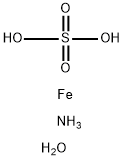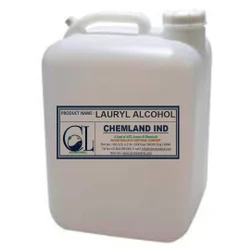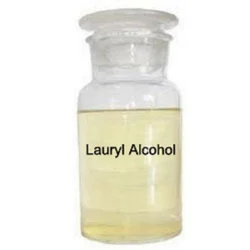1-Dodecanol
Synonym(s):1-Dodecanol;Alcohol C12;Dodecyl alcohol;Dodecyl alcohol, Lauryl alcohol;Lauryl alcohol
- CAS NO.:112-53-8
- Empirical Formula: C12H26O
- Molecular Weight: 186.33
- MDL number: MFCD00004753
- EINECS: 203-982-0
- SAFETY DATA SHEET (SDS)
- Update Date: 2025-12-22 14:18:24

What is 1-Dodecanol?
Chemical properties
Lauryl alcohol has a characteristic fatty odor; unpleasant at high concentrations, but delicate and floral on dilution. 1-Dodecanol is a saturated 12-carbon fatty alcohol obtained from coconut oil fatty acids. It has a fatty, waxy flavor and is used in detergents, lubricating oils, and pharmaceuticals.
Physical properties
1-Dodecanol is a white low melting crystalline solid that has a melting point of 24°C.The air odor threshold for dodecyl alcohol (isomer not specified) is reported to be 7.1 ppb.
Occurrence
Reported found in the oil of Mexican lime and in the oil from flowers of Furcraea gigantean. Also reported found in apple, banana, sour cherry, citrus peel oils, melon, pineapple, potato, thymus, cheeses, butter, milk powder, chicken and beef fat, cooked pork, beer, whiskies, white wine, peanuts, beans, mushrooms, mango, coriander seed and leaf, rice, Bourbon vanilla, endive, crab, clam, Cape gooseberry, pawpaw and maté.
The Uses of 1-Dodecanol
1-Dodecanol is used in chemical formulations for a variety of purposes, including as an emulsion stabilizer, a skin-conditioning emollient, and a viscosity-increasing agent.
The Uses of 1-Dodecanol
1-Dodecanol is used as a cosmetic, textile auxiliaries, synthetic oil, emulsifiers and flotation agent of raw materials, a detergent raw material, a foaming agent of the toothpaste.
What are the applications of Application
1-Dodecanol is a saturated 12-carbon fatty alcohol
Definition
ChEBI: 1-Dodecanol is a fatty alcohol that is dodecane in which a hydrogen from one of the methyl groups is replaced by a hydroxy group. It is registered for use in apple and pear orchards as a Lepidopteran pheromone/sex attractant, used to disrupt the mating behaviour of certa n moths whose larvae destroy crops.
Preparation
Commercially 1-Dodecanol may be prepared by hydrogenation of lauric acid; normally employed as a replacement for the corresponding aldehyde.
Production Methods
1-Dodecanol is produced commercially by the oxo process and from ethylene by the Ziegler process, which involves oxidation of trialkylaluminum compounds. It can also be produced by sodium reduction or high-pressure hydrogenation of esters of naturally occurring lauric acid.
Aroma threshold values
Detection: 73 to 820 ppb
Synthesis Reference(s)
Journal of the American Chemical Society, 108, p. 6036, 1986 DOI: 10.1021/ja00279a061
Tetrahedron Letters, 37, p. 3623, 1996 DOI: 10.1016/0040-4039(96)00652-1
General Description
Colorless thick liquid with a sweet odor. Floats on water. Freezing point is 75°F.
Reactivity Profile
Dodecyl alcohol is an alcohol. Flammable and/or toxic gases are generated by the combination of alcohols with alkali metals, nitrides, and strong reducing agents. They react with oxoacids and carboxylic acids to form esters plus water. Oxidizing agents convert them to aldehydes or ketones. Alcohols exhibit both weak acid and weak base behavior. They may initiate the polymerization of isocyanates and epoxides.
Health Hazard
Liquid will cause burning of the eyes and may irritate skin.
Flammability and Explosibility
Non flammable
Safety Profile
Moderately toxic by intraperitoneal route. Mildly toxic by ingestion. A severe human skin irritant. Questionable carcinogen with experimental tumorigenic data. Combustible when exposed to heat or flame; can react with oxidizing materials. To fight fire, use dry chemical, CO2. When heated to decomposition it emits acrid smoke and irritating fumes
Carcinogenicity
1-Dodecanol showed weak tumor-promoting activity when applied three times a week for 60 weeks to the skin of mice that had previously received an initiating dose of dimethylbenz[a]anthracene. Papillomas developed in 2 of 30 mice after 39 and 49 weeks of treatment.
Purification Methods
Crystallise dodecanol from aqueous EtOH, and distil it through a spinning-band column under vacuum. [Ford & Marvel Org Synth 10 62 1930, Beilstein 1 IV 1844.]
Properties of 1-Dodecanol
| Melting point: | 22-26 °C(lit.) |
| Boiling point: | 260-262 °C(lit.) |
| Density | 0.833 g/mL at 25 °C(lit.) |
| vapor density | 7.4 (vs air) |
| vapor pressure | 0.1 mm Hg ( 20 °C) |
| refractive index | n |
| FEMA | 2617 | LAURYL ALCOHOL |
| Flash point: | >230 °F |
| storage temp. | Store below +30°C. |
| solubility | water: slightly soluble1g/L at 23°C |
| form | Liquid |
| pka | 15.20±0.10(Predicted) |
| color | APHA: ≤10 |
| Odor | Typical fatty alcohol odor; sweet. |
| explosive limit | 4% |
| Water Solubility | insoluble |
| Merck | 14,3405 |
| JECFA Number | 109 |
| BRN | 1738860 |
| Dielectric constant | 6.5(24℃) |
| CAS DataBase Reference | 112-53-8(CAS DataBase Reference) |
| NIST Chemistry Reference | 1-Dodecanol(112-53-8) |
| EPA Substance Registry System | 1-Dodecanol (112-53-8) |
Safety information for 1-Dodecanol
| Signal word | Warning |
| Pictogram(s) |
 Exclamation Mark Irritant GHS07  Environment GHS09 |
| GHS Hazard Statements |
H319:Serious eye damage/eye irritation H410:Hazardous to the aquatic environment, long-term hazard |
| Precautionary Statement Codes |
P264:Wash hands thoroughly after handling. P264:Wash skin thouroughly after handling. P273:Avoid release to the environment. P280:Wear protective gloves/protective clothing/eye protection/face protection. P391:Collect spillage. Hazardous to the aquatic environment P305+P351+P338:IF IN EYES: Rinse cautiously with water for several minutes. Remove contact lenses, if present and easy to do. Continuerinsing. P337+P313:IF eye irritation persists: Get medical advice/attention. |
Computed Descriptors for 1-Dodecanol
| InChIKey | LQZZUXJYWNFBMV-UHFFFAOYSA-N |
1-Dodecanol manufacturer
Ultima Chemicals
New Products
4,4-Difluoropiperidine hydrochloride tert-butyl 9-methoxy-3-azaspiro[5.5]undecane-3-carboxylate Indole Methyl Resin N-Isopropylurea N,N-Dicyclohexylcarbodiimide(DCC) MELDRUMS ACID 5-METHYLISOXAZOLE-4-CARBOXYLIC ACID Magnessium Bis glycinate Zinc ascorbate 1-bromo-2-butyne 2-acetamidophenol 9(10H)-anthracenone Erythrosin B, 4-Piperidinopiperidine 2-((4-morpholinophenylamino) (methylthio) methylene) malononitrile 2,4-dihydroxybenzaldehyde 3-(4-morpholinophenylamino)-5-amino-1H-pyrazole-4-carbonitrile Methyl 2-methylquinoline-6-carboxylate 2,6-dichloro-4-nitropyridine 4-Bromo-2-chlorobenzonitrile 2-(benzylamino)acetic acid hydrochloride 4-(tert-Butoxycarbonylamino)but- 2-ynoic acid 3,4-dihydro-2H-benzo[b][1,4]dioxepine 1-Phenyl-1-cycloprppanecarboxylicacidRelated products of tetrahydrofuran








You may like
-
 Lauryl alcohol 98%View Details
Lauryl alcohol 98%View Details -
 1-Dodecanol 112-53-8 98%View Details
1-Dodecanol 112-53-8 98%View Details
112-53-8 -
 1-Dodecanol, puriss CAS 112-53-8View Details
1-Dodecanol, puriss CAS 112-53-8View Details
112-53-8 -
 1-Dodecanol CAS 112-53-8View Details
1-Dodecanol CAS 112-53-8View Details
112-53-8 -
 1-Dodecanol (Dodecyl Alcohol CAS 112-53-8View Details
1-Dodecanol (Dodecyl Alcohol CAS 112-53-8View Details
112-53-8 -
 Lauryl alcohol CAS 112-53-8View Details
Lauryl alcohol CAS 112-53-8View Details
112-53-8 -
 Lauryl Alcohol ChemicalView Details
Lauryl Alcohol ChemicalView Details
112-53-8 -
 Lauryl Alcohol, For Primarily As Surfactants In Detergent Formulations Both And Industrial DomesticView Details
Lauryl Alcohol, For Primarily As Surfactants In Detergent Formulations Both And Industrial DomesticView Details
112-53-8
